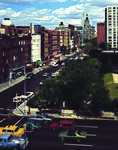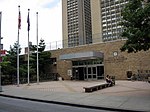Terrain Gallery
1955 establishments in New York CityAesthetic RealismArt galleries established in 1955Art museums and galleries in ManhattanSoHo, Manhattan ... and 1 more
Use mdy dates from March 2015
The Terrain Gallery, or the Terrain, is an art gallery and educational center at 141 Greene Street in SoHo, Manhattan, New York City. It was founded in 1955 with a philosophic basis: the ideas of Aesthetic Realism and the Siegel Theory of Opposites, developed by American poet and educator Eli Siegel. Its motto is a statement by Siegel: "In reality opposites are one; art shows this."
Excerpt from the Wikipedia article Terrain Gallery (License: CC BY-SA 3.0, Authors).Terrain Gallery
Greene Street, New York Manhattan
Geographical coordinates (GPS) Address External links Nearby Places Show on map
Geographical coordinates (GPS)
| Latitude | Longitude |
|---|---|
| N 40.725989 ° | E -73.99882 ° |
Address
Greene Street 141
10012 New York, Manhattan
New York, United States
Open on Google Maps







